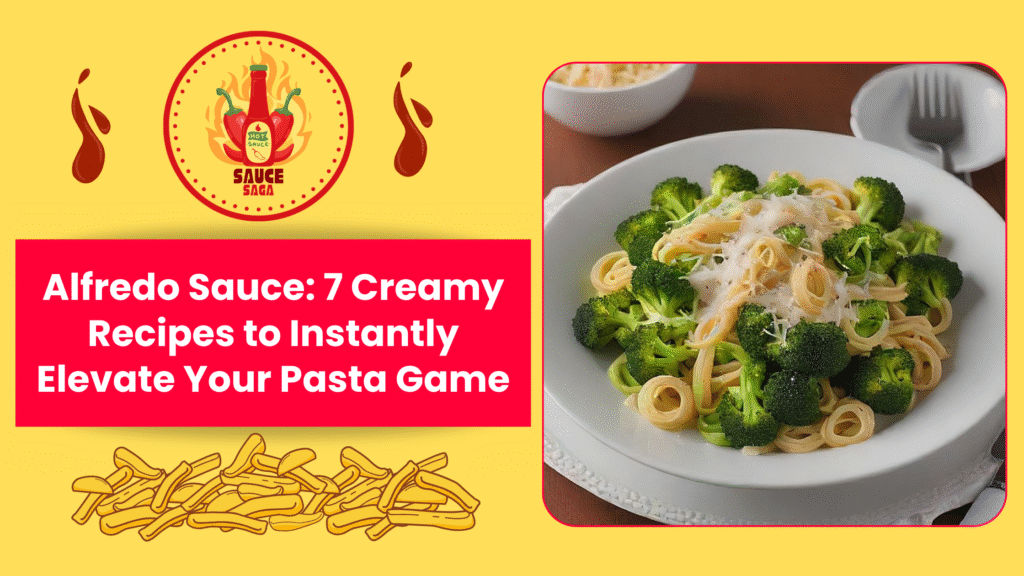Table of Contents
Introduction: Why Pesto Sauce Deserves a Place in Every Kitchen
It is not new in the Italian cuisine and there is a good reason to that. The classic pesto (or pesto alla Genovese) was said to have been developed in the region of Liguria in North of Italy whereby the combinations of fresh basil leaves, garlic, pine nuts, Parmesan cheese and Olive oil were pounded on the palms of the mortar and pestle. Pesto in the Italian language has an even name pestare meaning which can be translated to it means that to crush.
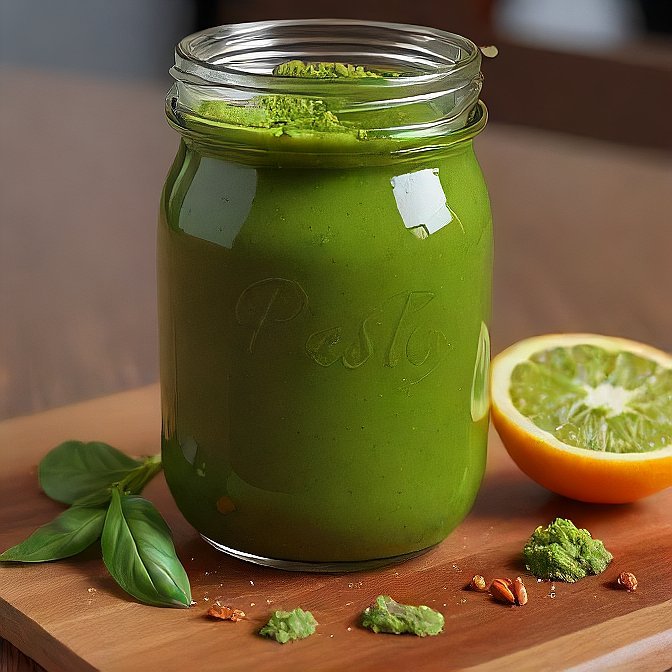
This is a simple yet powerful sauce that was able to spread all over the world with the passage of time. It may be your traditional pasta recipes or anything new and fancier that comes in the form of bowls, cafe sandwiches, and dips, but one thing is clear that pesto is a packet of flaunting flavour, wholesome and freshest ingredients, and not to mention, endless variety in a single spoon! It is creamy, its color is bright green, and the nutty flavor of the herbs used gives it the quality of an ideal ingredient that one can include in any dish to add a sense of something new to the food without having to work on it too hard.
One of the best parts is its good that it is already completed. Making pesto at home is so easy and adjustable. You can exchange herbs, nuts, cheeses, or you can make it dairy-free. Homemade pesto can be fresher and healthier, and has no preservatives since the jars in which it is kept only need to store there some weeks.
There are 6 alternative, varied pesto sauce recipes in the post, other than the traditional one made using basil. It does not matter whether you choose sun-dried tomato, vegan, or even spicy cilantro lime; you choose it because it is made to help you turn a standard dish into a memorable one.
Let’s dive into the flavor.
1. Classic Basil Pesto – Fresh, Bold, and Always in Season
It is one particular form of pesto sauce that will pop into mind when discussing it with most people. Conventional basil pesto is light, delicious, and it has been announced the most fantastic adaptable food on the face of the earth, the veritable Italian timeless preferred that bizarrely enhances nearly every other delicacy.
Old-fashioned pesto sauce. This is the one that I use in the kitchen, either as a sauce in a pasta or even as an ingredient in a dish, or more than likely as a dip.

The Use of Traditional Ingredients to Get Authentic Flavor
The classic pesto is made by only a few freshest and simplest ingredients:
- Leaves of fine basil
- Garlic cloves
- Pine nuts
- Shaving Parmesan cheese
- The extra virgin olive oil
- Optional: some salt, and some lemon juice to create more balance
The ingredients play their great role, as they also make the rich herbal experience with a creamy and nutty outlook.
Ways to Use Classic Basil Pesto
This pesto does not have to be served with pasta, though it goes so well with spaghetti or penne. It is also possible to:
- Apply on the pizza crust, then put toppings
- Make it a sandwich or wrap, spread
- Pour on scrambled eggs, chicken coated in the grill, or roast vegetables
- Combine with mayo or Greek yogurt to get a quick pesto dip
It is an all-purpose sauce that can be used in breakfast, lunch, dinner, and snacks.
Tips for Bright Color and Smooth Texture
To maintain your basil pesto as green and silky:
- You should use cold olive oil and need to blend basil as fast as possible to prevent discoloration due to heat
- Blend boiled basil leaves (5 sec) in water and shock basil leaves in ice stream (optional yet good)
- To make it smooth and homogenous,a food processor or a mortar and pestle should be utilized
With a fresh pesto of basil, made home-made, there is a certain flavour, a certain fragrance, which you simply cannot have out of a jar. It is an adventure, commanding and never out of fashion, even when you are using your home-grown basil or a bunch taken out of the supermarket.
2. Sun-Dried Tomato Pesto – A Sweet & Savory Mediterranean Take
Feel like trying something a tad fatter and richer in flavor as compared to the classic green pesto? Also known as pesto rosso, the sun-dried tomato pesto is a strong, slightly sweet, savory spice that works best with Mediterranean-based types of recipes.
This sauce makes any food taste extra special, and this vegetable tomato pesto is a nice twist when compared to its unhealthy version of basil.

How to Blend for Bold Flavor
What makes fantastic sun-dried tomato pesto is being able to balance intensity and vividness. The following will be what you need:
- Oil-packed Sun-dried tomatoes (dry tomatoes that have been reconstituted)
- Garlic cloves
- Roasted nuts: Almonds, walnuts or pine nuts
- Basil, or parsley, opened herbs
- Ground Parmesan cheese
- Smooth blending of olive oil
- Optional: one to two splashes of balsamic vinegar to further give depth
Put everything together in a food processor and mix until smooth, though chunky. Add the olive oil in portions to regulate consistency.
Best Ways to Use Sun-Dried Tomato Pesto
This pesto thrives in meals that call for a deeper, more salty taste:
Crostini or bruschetta- as a savoury first dish
- Pasta salads – stir in fusilli, penne ,or orzo
- Roasted vegetables – throw in some zucchini, eggplant, or even mushrooms
- Grain bowls and wraps bring the richness and color
Optional Add-Ins for Extra Flavor
Fancy going further? Try:
- Spicy chill flakes
- Lemon zest as a lightening effect to the sauce
- Feta in crumbs to finish off creamy and salty
When you need something hearty, colorful, and full of umami flavor, you should choose sun-dried tomato pesto. It keeps in the refrigerator and puts instant Mediterranean style on any dish.
Check Out: Alfredo Sauce: 7 Creamy Recipes to Instantly Elevate Your Pasta Game.
3. Spinach Walnut Pesto Sauce – A Nutritious Take on the Classic
When in need of another option to basil pesto that is cheap as well as nutritious, spinach walnut pesto is likewise an ideal choice. It is full of iron, fiber, and healthy fats, and it has a smooth, mellow taste, which even the picky eaters tend to appreciate.
To have something healthier, yet very tasty, give this spinach pesto sauce a swirl- it will allow adding more and more healthy greens to the nutrition without having to compromise on the taste.
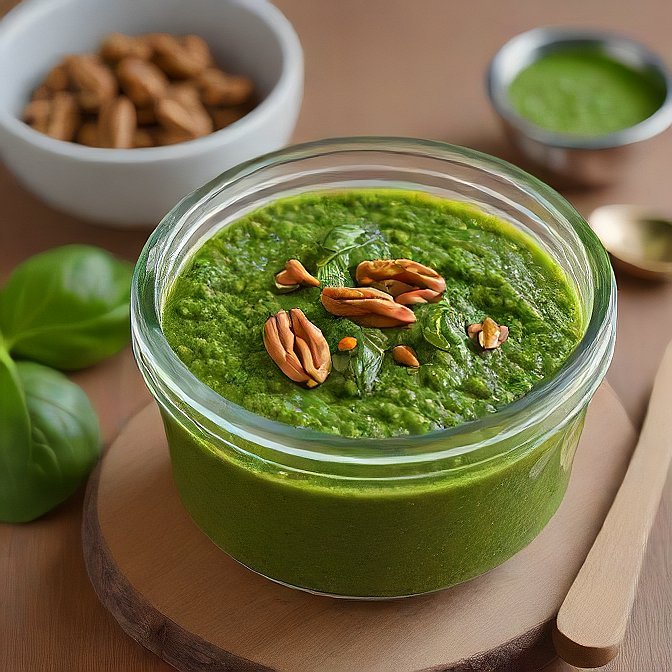
Why Spinach and Walnuts Work So Well
Spinach is bland, a bit sweet, and mixes well with a creamy sauce. Walnuts provide a light crunch, with an earthy richness it also adds, and it is cheaper than pine nuts. This mixture makes the pesto have a smooth finish, a bright green color with faint nutty taste.
This is what you will need:
- Uncooked spinach (baby spinach is most appropriate)
- Toasted walnuts ( Not too crunchy)
- Garlic cloves
- Nutritional yeast or Grated Parmesan
- Olive oil
- Optional: lemon juice squeezed to bring out brightness
Simply dump all in a food processor or blender and mix to a creamy consistency.
How to Use Spinach Walnut Pesto
This version is extremely flexible and can be applied to both warm and cold meals:
- Applied to sandwiches or wraps
- Veggies, crackers, and pita chips to dip in the pita chips
- Throw in sweetened warm bowls of quinoa or couscous
- Combined into scrambled eggs or cottage cheese
Kid-Friendly and Meal Prep-Ready
Owing to its pleasing taste and appearance, spinach can be easily incorporated as a snack for kids. It can be prepared in a very large quantity and kept refrigerated, or you can freeze some of it to reserve for a later date.
When you are in a pinch and want an easy, clean, and yet delicious sauce without feeling deprived, spinach walnut pesto is a great idea.
4. Vegan Pesto Sauce – Dairy-Free and Packed with Flavor
There is no need to use milk products to have a creamy pesto. This vegan pesto sauce cleverly ushers all the classic pesto flavors, and none of the cheese. It is also perfect to those people who maintain a plant-based diet or to anyone who desires to make things light.
It is a rich creamy dairy free vegan pesto sauce with which healthier and allergic free foods can be prepared.
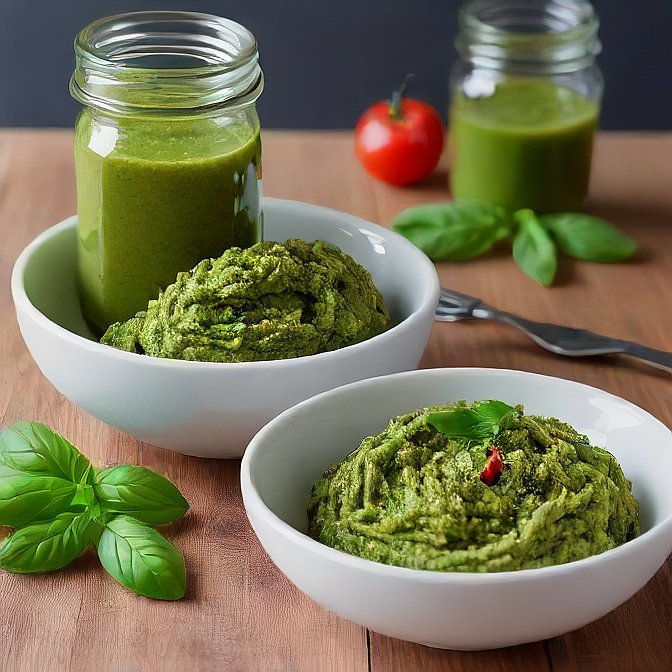
How to Replace Cheese Without Losing Flavor
The standard pesto is based on Parmesan, whereas this one has its cheesy, salty zing thanks to:
- Nutritional yeast: to give Dimension cheesy and providing vitamin B12 to the food
- Parmesan is of vegan eggs and consists of cashews, garlic powder, and nutritional yeast (ready-made or homemade)
These alternatives make the sauce creamy and deep in non-dairy form and are health-packed as well.
Best Oils and Nut Substitutes for Rich Texture
Vegan pesto can be made creamy and good:
- Extra virgin olive oil -Old world, full flavored
- Avocado oil – to have a milder taste and healthy fats
- Cashews or sunflower seeds – allergy-free replacements to pine nuts or walnuts that are creamy
- Hemp seeds or pumpkin seeds – a fantastic source of extra protein and good texture
In a container, mix with garlic, fresh herbs (such as basil or parsley), lemon juice, and oil you like, and smooth it out.
Where to Use Vegan Pesto
This cream-free pesto sauce is very versatile:
- Add to the roast vegetables to enhance the taste
- Top grain bowls, wraps, or avocado toasts
- Put on salads or use as a cracker dip
This pesto is cheeseless, and it is vegan-friendly, although curiosity might be all it takes to enjoy this creamy, intense pesto flavor.
5. Cilantro Lime Pesto – Zesty, Bright, and Great with Tacos
In search of a pesto with strong, shocking flavor? This cilantro lime pesto will be your solution. It is zesty, moderately acidic, and gives a fresh touch to a classic pesto salad – an ideal summer dish, Mexican-style combinations, and others.
Its cilantro pesto sauce will make every bite spicy and will add a fresh and new flavor to your dishes.
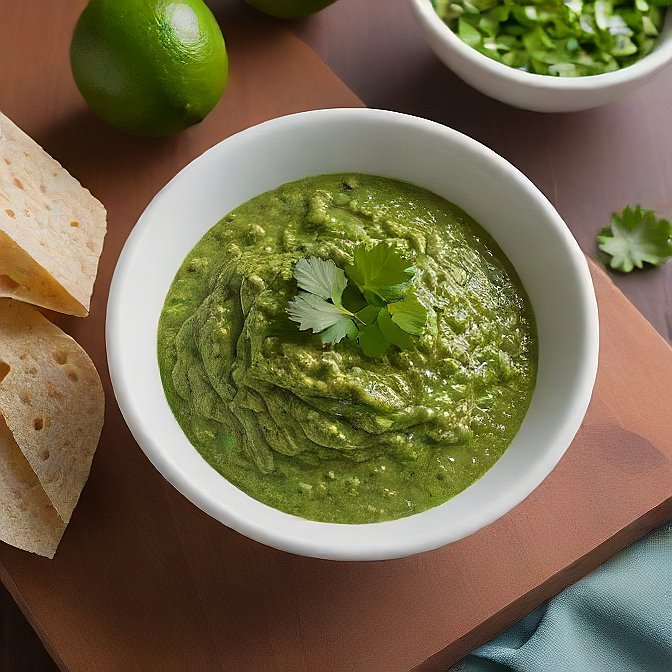
Flavor Base: Cilantro, Lime, Almonds, and Garlic
The variety swaps the basil with fresh cilantro and switches the pine nuts with the toasted almonds, which brings about a smooth, nutty bite
. In this, you will require:
- Fresh (tender stems are okay) cilantro leaves
- Zest and fresh juice of limes
- Roasted cashews or almonds
- Garlic cloves
- Avocado oil or olive oil
- Additional: jalapeño to add heat to it, or honey to sweeten it
Blend until smoothened, adding the oil and lime to the desired level of smoothness and tanginess.
Best Uses for Cilantro Lime Pesto
The pesto is gorgeous in Latin and Southwestern cuisine:
- Top tacos, burritos or quesadillas
- Stir in rice bowls or quinoa bowls
- Place some grilled shrimp, chicken, or vegetables
- Slaw dressing, Taco salads
It can be used to tone down rich meals made of pasta or chili food and fill them with a refreshing flavor due to its acidic taste.
Tips to Reduce Bitterness and Enhance Balance
In some cases, cilantro tastes bitter to delicate tastes. To correct that:
- Take fresh and bright green leaves (no yellow or wilted leaves should be used)
- Add an extra lime juice to remedy the bitterness
- Add just a dash of honey or syrup in case of maple syrup flavour.
- The lightened form of taste is the roasted garlic, which is sweeter
It is a spicy, tangy replacement to basil pesto that is sure to brighten up all of your meals, especially when zesty and light are necessities.
6. Pesto Rosso (Red Pesto) – Smoky, Bold, and Full of Depth
Pesto Rosso, so-called red pesto, is a must-have in case you are a fan of strong, salty taste. It mixes roasted red bell pepper, sun-dried tomatoes, and almonds to form a smoky, sweet, rich sauce.
Use your meals and kick it up by using this smoky red pesto sauce either when making pastas, lasagna, or even imparting flavor on some grilled foods.

Key Ingredients for Deep, Savory Flavor
This change of pesto kicks green herbs by replacing them with red vegetables and retains the creaminess, like the pesto is known to be. The following is what you will need:
- homemade or jarred roasted red bell pepper
- So-dried tomatoes (best oil-stuffed)
- Toasted almonds (or cashew nuts in case you want it creamier)
- Garlic cloves
- Olive oil
- Optional: one spoonful of tomato paste or smoked paprika to boost the flavours
Stir until creamy and sufficiently thick. You may take something of the sun-dried tomato oil or a dash of water to improve the consistency.
Perfect Pairings for Red Pesto Sauce
Pesto Rosso is strong enough to make itself stand out in hearty dishes:
- Lasagna or baked pasta – an extra taste of smokiness to cheesy layers
- Soups or stews: A spoon will do the trick to add an umami boost
- Grilled foods or fish – grill over steak, chicken, or prawns
- Sandwiches and flatbreads – apply as a smoky spread
It goes well as an all-around sauce when you are in need of something with heft and character.
How to Roast Red Peppers at Home
To taste best:
- Wash, cut peppers into halves remove seeds and stems.
- Place with skin uppermost in the 425 °C (220 °C) oven and bake for 2025 minutes
- As long as a lot of black and blistered is reduced to a covered bowl for 10 minutes
- Pick and stir them up.
Fresh roasted peppers that you make yourself provide your pesto with the smokiness and natural sweetness that can hardly be found in the bought jars.
Bonus Tips: How to Store, Freeze, and Reuse Pesto Sauce
When you have prepared a part of the homemade pesto sauce, it is essential to store it in the right way to maintain the sauce fresh and tasty. The positive news is? Pesto is a kind of sauce that is the most convenient to store and then to use creatively during the whole week, or even months later.
Freeze your homemade pesto sauce in the right manner so that you can do justice to the last drop of pesto sauce.
Refrigeration: How Long Does It Last in the Fridge
Homemade pesto can last up to 5 4 days when it is kept in a tight container in the freezer. To aid in maintaining its vivid green color and avoiding oxidation:
- Pour out a little olive oil on top and seal the jar
- It is also very important to use a spoon which is clean spoon to scoop out portions
This helps preserve the flavors and helps keep the pesto from spoiling within a short time.
Freezing: Ice Cube Trays Make It Easy
To store long-term, freeze your pesto in ice cube trays. When frozen, just pop out the cubes and put them into a zip-top freezer bag. Using this option, you can:
- Cut a precise amount that you need, so nothing is wasted
- Thaw at a speed to make weeknight dinners
- Use pesto at times when fresh herbs are not available
Pesto can be frozen up to 3 months, and it is equally good to have when thawed and stirred into warm foods.
Creative Ways to Reuse Pesto Sauce
There are so many other uses of pesto in your meals:
- Chicken/tofu/shrimp marinade
- Thinned up salad dressing with lemon or vinegar
- White-bread spread
- Churned into soups, in particular tomato or vegetable-based soups
- Thrown with baked potatoes or grains, or scrambled eggs
It is enough that even a small spoonful can change the whole dish overall and it is exactly for this reason that pesto is the most versatile and multipurposed homemade sauce that you can find.
Conclusion: Which Pesto Sauce Will You Try First?
Whether credibly green or fiery red and tangy citrus ranges, pesto sauce is limitless with respect to taste, healthfulness, and kitchen artistry. If you are fond of something you are already accustomed to or you are ready to taste something unusual and uncommon you will have a lot of changes of pesto which will meet your appetites.
So what were the six pesto culinary sauce recipes that you read that were quick and tasty?
- Classic Basil Pesto, although it is fresh, sharp, and can be incorporated with any food.
- Sun-dried Tomato Pesto– Sweet and savory, and with a Mediterranean taste
- Spinach Walnut Pesto is a healthy, cost-effective variation
- Vegan Pesto – This is rich, creamy, and all dairy-free!
- Cilantro Lime Pesto– Tangy, limey, and ready-to-taco
- Pesto Rosso (Red Pesto) Smoky, aggressive, and rich
You can alter every recipe according to your taste. There can be an effort to replace herbs (e.g. basil, cilantro, or parsley). Choose to eat one or more of the kinds of nuts or seeds, including almonds, walnuts, or sunflower seed. Even such oils as avocado oil or flaxseed oil can add another texture and flavor to pesto.
Start with whichever you have and in a few minutes, fresh home made pesto will make boring everyday food taste special.
For more info: Click Here.
FAQs About Pesto Sauce
1. Can pesto sauce be made without nuts?
s, absolutely. To make pesto without nuts, you can use it in case of a nut allergy, or to make a cheaper alternative. As great substitutes:
- Sunflower seeds
- Pumpkin seeds
- Hemp seeds
These are offering a texture and richness that are in some way similar, without changing the flavor that much. Also, you may forget about the nuts to get a lighter sauce.
2. How do I fix bitter pesto sauce?
Over-blended basil or olive oil normally has a taste of bitterness in it. To rectify it:
- Squeeze some lemon juice to add lightness to the taste
- Add some Parmesan cheese or nutritional yeast to balance it out
- Add a few drops of honey or maple syrup to take away the bitter edges, in case they persist
No need to process the ingredients too much as well – their blending should not go on too long so that the natural sweetness of basil would not be stripped away.
3. Can one make pesto sauce without cheese?
Don’t believe me, you can have fantastic cheese-free pesto by using instead than cheese:
- Nutritional yeast (to taste like cheese, nutty)
- Smooth tofu (to make it more creamy) (optional), Cashews
It will be great as an alternative to those who are vegans or do not take dairy. The resultant product is eminent, tasty, and it renders it suitable to be used in sandwiches, pasta, etc.

